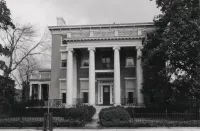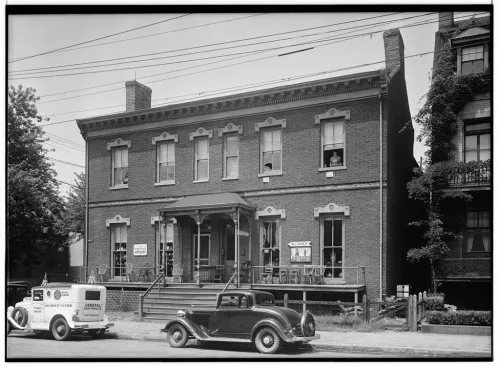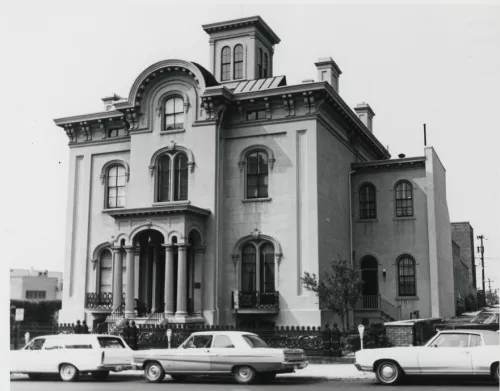Share what you know,
and discover more.
Share what you know,
and discover more.
Dec 18, 1970

-

- Charmaine Bantugan
National Register of Historic Places - Kent-Valentine House
Statement of Significant: Documented evidence indicates that Horace Kent of Richmond had his home built in 1845 from plans by Isaiah Rogers of Boston. Rogers, who was known for his revolutionary hotel designs and who designed the now demolished Exchange Hotel and Exchange Bank in Richmond, was described by Talbot Hamlin as "one of the most remarkable designers of the entire Greek Revival movement". The diary of Rogers indicates that a Mr. Kent requested plans in 1841 as well as in 1844, that apparently the 1841 plans were rejected, and that Rogers was in that period designing a Gothic Revival house for E. Reddington Mudge in Swampscott, Massachusetts, suggesting an interior much like the western double parlour at the Kent- Valentine House. The former was destroyed and thus the latter is the only identified residential structure standing designed by Rogers. Granville G. Valentine purchased the house in 1904 and proceeded to make considerable alterations. The one-story iron porch which had extended the full length of the front and around the west corner was removed when the present portico was built, and the iron was retained only between the columns. The three-story bay was expanded to five bays. The interior was altered to the Colonial Revival tastes except for the double parlour. The Kent-Valentine House with its quarter-block, park-like setting, occupies an important point on the northwest corner of First and Franklin Streets across First Street from Linden Row, a magnificent range of eight Greek Revival townhouses. Together, these two architectural units form an important visual element in the fast-disappearing historic character of Franklin Street.
National Register of Historic Places - Kent-Valentine House
Statement of Significant: Documented evidence indicates that Horace Kent of Richmond had his home built in 1845 from plans by Isaiah Rogers of Boston. Rogers, who was known for his revolutionary hotel designs and who designed the now demolished Exchange Hotel and Exchange Bank in Richmond, was described by Talbot Hamlin as "one of the most remarkable designers of the entire Greek Revival movement". The diary of Rogers indicates that a Mr. Kent requested plans in 1841 as well as in 1844, that apparently the 1841 plans were rejected, and that Rogers was in that period designing a Gothic Revival house for E. Reddington Mudge in Swampscott, Massachusetts, suggesting an interior much like the western double parlour at the Kent- Valentine House. The former was destroyed and thus the latter is the only identified residential structure standing designed by Rogers. Granville G. Valentine purchased the house in 1904 and proceeded to make considerable alterations. The one-story iron porch which had extended the full length of the front and around the west corner was removed when the present portico was built, and the iron was retained only between the columns. The three-story bay was expanded to five bays. The interior was altered to the Colonial Revival tastes except for the double parlour. The Kent-Valentine House with its quarter-block, park-like setting, occupies an important point on the northwest corner of First and Franklin Streets across First Street from Linden Row, a magnificent range of eight Greek Revival townhouses. Together, these two architectural units form an important visual element in the fast-disappearing historic character of Franklin Street.
Dec 18, 1970
National Register of Historic Places - Kent-Valentine House
Statement of Significant:Documented evidence indicates that Horace Kent of Richmond had his home built in 1845 from plans by Isaiah Rogers of Boston. Rogers, who was known for his revolutionary hotel designs and who designed the now demolished Exchange Hotel and Exchange Bank in Richmond, was described by Talbot Hamlin as "one of the most remarkable designers of the entire Greek Revival movement". The diary of Rogers indicates that a Mr. Kent requested plans in 1841 as well as in 1844, that apparently the 1841 plans were rejected, and that Rogers was in that period designing a Gothic Revival house for E. Reddington Mudge in Swampscott, Massachusetts, suggesting an interior much like the western double parlour at the Kent- Valentine House. The former was destroyed and thus the latter is the only identified residential structure standing designed by Rogers.
Granville G. Valentine purchased the house in 1904 and proceeded to make considerable alterations. The one-story iron porch which had extended the full length of the front and around the west corner was removed when the present portico was built, and the iron was retained only between the columns. The three-story bay was expanded to five bays.
The interior was altered to the Colonial Revival tastes except for the double parlour. The Kent-Valentine House with its quarter-block, park-like setting, occupies an important point on the northwest corner of First and Franklin Streets across First Street from Linden Row, a magnificent
range of eight Greek Revival townhouses. Together, these two architectural units form an important visual element in the fast-disappearing historic character of Franklin Street.
Posted Date
Jul 12, 2023
Historical Record Date
Dec 18, 1970
Source Name
National Register of Historic Places
Source Website
Delete Story
Are you sure you want to delete this story?










